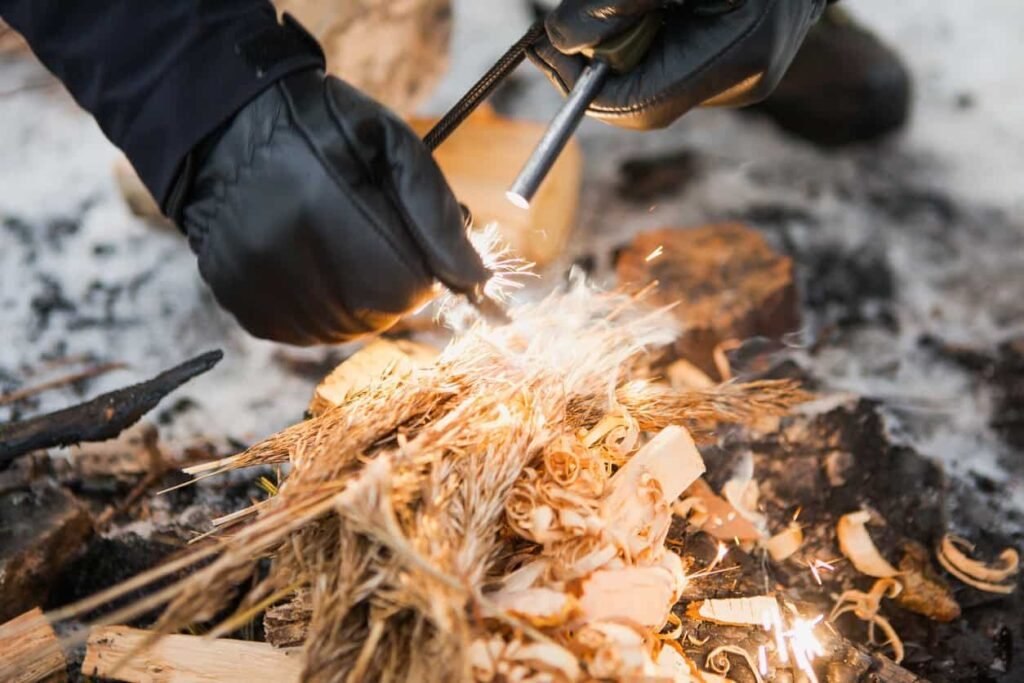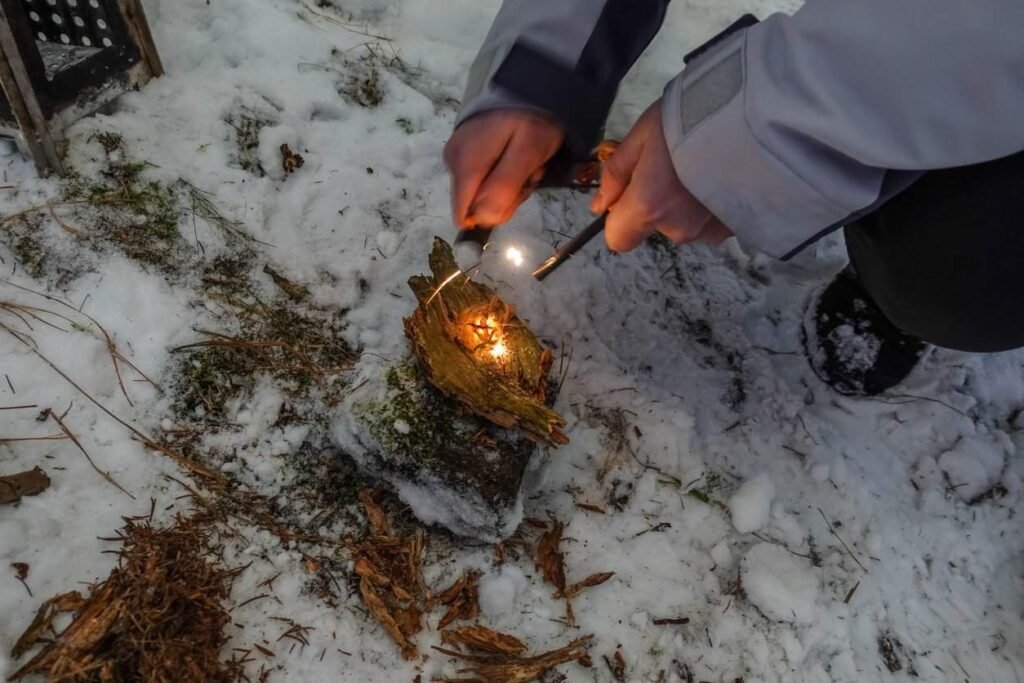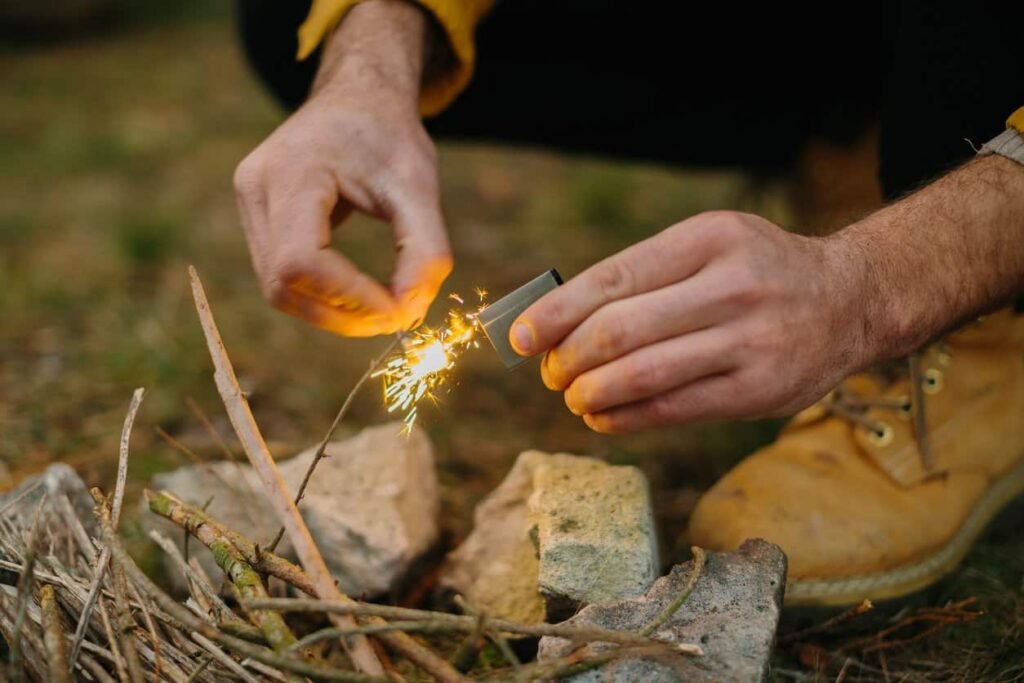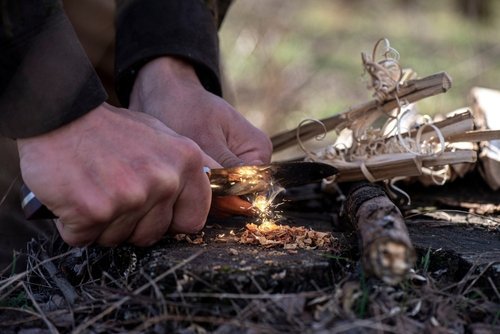
When it comes to survival gear, particularly tools to start fires, two contenders often come to mind: ferro rods and magnesium fire starters. Both have their merits, but which one stands out as the superior choice? In this comprehensive guide, we’ll delve deep into the characteristics, advantages, and potential downsides of both.
Understanding the Basics

What is a Ferro Rod?
A ferro rod, often referred to as ferrocerium, represents a synthetic pyrophoric alloy capable of generating sparks upon contact with a coarse surface or a designated striker. These sparks possess the remarkable ability to achieve scorching temperatures, reaching as high as 5,430°F (3,000°C). This incredible heat output makes them exceptionally effective at igniting a diverse range of tinder materials. Ferro rods have garnered widespread acclaim among survivalists, bushcraft enthusiasts, and campers, primarily due to their unmatched reliability under diverse environmental conditions. For those eager to explore the scientific intricacies and historical background of ferro rods, a comprehensive resource can be found in this detailed article by Outdoor Life.
What is Magnesium?
Magnesium, in the context of fire-starting, refers to a flammable metal often used alongside ferro rods. Many magnesium fire starters come as a block with an embedded ferro rod. When shavings from the magnesium block are struck with sparks from the ferro rod, a flame erupts, burning at an astounding temperature of around 5,610°F (3,100°C). This makes magnesium an invaluable asset in difficult conditions where tinder might be damp. For a step-by-step guide on how to effectively use a magnesium fire starter, WikiHow offers a comprehensive tutorial.
Ferro Rod vs. Magnesium – A Comparative Analysis

The Mechanism of Spark Generation
While both ferro rod and magnesium are used in the realm of fire-starting, their mechanisms of action differ. Ferro rods produce sparks when a rough surface or a striker scrapes off tiny particles from the rod. The friction and pressure cause these particles to oxidize rapidly in the air, producing the characteristic sparks. On the other hand, magnesium needs to be shaved into tiny slivers or filings. When these magnesium filings come into contact with a spark, they combust in a brilliant, high-temperature flame. For a deeper dive into the science behind these reactions, ThoughtCo explains the chemistry of fire-starters.
Durability and Longevity
Ferro rods generally last longer than magnesium blocks. Since only a few particles are scraped off with each strike, a single ferro rod can provide thousands of fires. Magnesium, however, needs to be shaved off in larger amounts to ensure ignition, leading to faster wear and tear. But there’s a silver lining: when combined, as seen in many fire starter kits, they can complement each other beautifully. SurvivalCache provides a detailed review on the longevity of various fire-starting tools.
Efficacy in Adverse Conditions
One major advantage of both ferro rods and magnesium blocks is their capability to work in adverse conditions. Whether it’s raining, snowing, or windy, a ferro rod will always produce sparks. Magnesium, too, can be invaluable in wet conditions. The high temperature at which magnesium burns ensures ignition even with damp tinder. Backpacker Magazine discusses the effectiveness of these tools under different environmental conditions.
Safety Considerations
Both ferro rod and magnesium have inherent safety considerations. Ferro rod sparks, due to their short-lived nature, are generally safe and cause minimal harm unless directed at inflammable material or skin from close proximity. Magnesium, with its brilliant white flame, can be more dangerous, especially if large amounts are ignited simultaneously. Proper precautions, as detailed by OutdoorLife in their safety guidelines, should always be taken.
By analyzing the above factors, it becomes clear that both ferro rods and magnesium have their unique strengths and drawbacks. Depending on specific needs and environmental conditions, one might be preferred over the other, or they can be used in tandem for the best results.
The Historical Evolution of Fire-starting Tools

Stone Age Fire-starting
The earliest humans likely discovered fire by chance, such as through lightning strikes. However, they quickly learned to harness its power, using stones to create sparks. Flint, with its sharp edges, was a popular choice. Striking flint against iron pyrites would produce sparks capable of igniting tinder. The remnants of such fire-making tools have been found in archaeological digs across Europe and Asia.
The Birth of Fire Pistons
Originating in Southeast Asia, the fire piston represented a significant advancement in fire-starting technology. This tool used rapid air compression to ignite tinder. When a cylindrical piston was quickly slammed into a chamber, the air inside got compressed, increasing its temperature and igniting the tinder placed inside. This method was popular in regions where flint was rare.
From Bow Drills to Ferro Rods
Bow drills, which used friction to generate heat, were a precursor to modern fire-starters. By rotating a spindle against a wooden base using a bow, enough heat could be generated to ignite tinder. The principle of using friction and sparks was later refined with the invention of ferrocerium rods in the 20th century. The ability of these rods to produce consistent sparks made them a popular choice among outdoor enthusiasts and survivalists.
Magnesium – The Modern Marvel
As the need for more effective and weather-resistant fire-starting tools grew, magnesium emerged as a reliable solution. Its ability to produce high-temperature flames even in damp conditions made it an invaluable tool for campers and military personnel. Many modern survival kits now include magnesium blocks alongside ferro rods for this reason.
For a visual journey of the evolution of fire-starting tools, this documentary by the History Channel offers a detailed overview.
The Science Behind Ferro Rods and Magnesium

Ferro Rods: An Alloy’s Spark
Ferrocerium, the main component of ferro rods, isn’t a naturally occurring material but rather an alloy. It’s primarily composed of iron (Fe) and cerium (Ce). When scraped or struck, tiny fragments of this alloy are shaved off. The friction from this action provides the necessary heat, allowing these fragments to reach their ignition temperature and produce sparks.
The sparks from a ferro rod can reach temperatures of about 3,000 degrees Celsius (5,432 degrees Fahrenheit), hot enough to ignite a wide variety of tinders.
Magnesium: Flammable Lightweight Metal
Magnesium is an element (Mg on the periodic table) and is known for its lightweight properties in alloys and its high flammability. When magnesium shavings are exposed to a flame, they ignite in a brilliant white flame, reaching temperatures close to 4,000 degrees Fahrenheit (2,204 degrees Celsius).
However, one might wonder, “If magnesium is so flammable, isn’t it dangerous to carry around?” The answer lies in its physical form. In a solid block or stick, magnesium doesn’t easily ignite. It’s only when it’s shaved into small particles that its surface area increases, making it easy to ignite.
For an in-depth look into how magnesium reacts under various conditions, this educational video provides valuable insights.
Comparative Analysis
While both ferro rods and magnesium are revered for their fire-starting capabilities, their applications differ slightly:
- Ignition Temperature: Ferro rod sparks are hot, but magnesium shavings burn at even higher temperatures.
- Weather Resistance: Both can function in damp conditions, but magnesium’s ability to create intense heat can help ignite even slightly damp tinder.
- Ease of Use: Ferro rods might have a slight edge here, as they don’t require shaving off material. With magnesium, you’ll need to scrape off shavings before striking a spark.
In essence, while each has its unique strengths, having both in a survival kit can ensure you’re prepared for a wide range of scenarios.
Application in Real-Life Survival Situations

In survival scenarios, every second counts, and the environment is often unpredictable. Both ferro rods and magnesium come to the rescue in distinct ways:
- Harsh Weather Conditions: When you’re stuck in damp or wet environments, lighting a fire can be daunting. Magnesium, with its intense heat, can help ignite even damp tinder, making it indispensable for rainy or snowy conditions.
- Ease of Transportation: Given their compact nature, ferro rods are easy to attach to keychains or fit into small pockets of backpacks. Their lightweight ensures that they don’t become a burden during long treks.
- Versatility: Beyond just fire-starting, ferro rods can also be used as a signal in emergencies due to the bright sparks they produce, potentially alerting rescuers.
Ultimately, understanding the practical applications of these tools can be the difference between mere survival and thriving in challenging situations.
FAQ
- Q1:Can you use a magnesium fire starter without the ferro rod?
A:It’s possible but challenging. Magnesium shavings can be ignited with matches or a lighter, but the built-in ferro rod simplifies the process. - Q2:How long do ferro rods and magnesium blocks last?
A:With regular use, ferro rods can last several years, while magnesium blocks’ longevity depends on how often you scrape off shavings. - Q3:Are there any safety precautions to be aware of?
A:Always use fire starters in open areas away from flammable materials. Store them safely, away from children. - Q4:Do both tools work in windy conditions?
A:Both tools can function in windy conditions. However, the magnesium’s hot and intense flames might have a slight edge in particularly gusty scenarios. - Q5:How do I store these fire-starters when not in use?
A:Keep them in a dry place, preferably in a sealed bag or container. Avoid leaving them in extremely damp environments for extended periods.
Conclusion
Choosing between a ferro rod and a magnesium fire starter often boils down to personal preference, specific needs, and the situations you anticipate encountering. While ferro rods are hailed for their versatility and longevity, magnesium fire starters shine in damp conditions and provide an integrated fire-starting system. Whatever your choice, ensuring you know how to use your tool effectively is paramount. Interested in seeing these tools in action? Check out this external video link for hands-on demonstrations and expert advice. As always, prioritize safety and respect nature in all your outdoor adventures.


